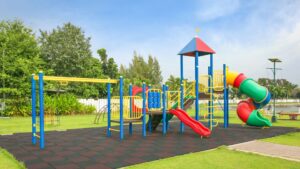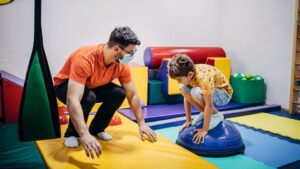Soy profesora de evaluación de integración sensorial y cada año evalúo la integración sensorial de más de 100 niños. La mayoría de estos niños padecen trastornos del desarrollo como autismo, parálisis cerebral, discapacidad intelectual, trastornos del lenguaje, TDAH y retrasos del desarrollo. Muchos de ellos presentan síntomas de disfunción de la integración sensorial.
Sin embargo, la mayoría de los niños con un desarrollo típico no experimentan disfunciones de integración sensorial. Si alguien afirma que tu hijo tiene problemas de integración sensorial tras unas pocas clases, su principal objetivo podría ser venderte sus programas de formación.

¿Qué es la integración sensorial?
La integración sensorial es un concepto introducido por el Dr. Ayres de la Universidad de California en 1972. Dividió los sentidos en siete tipos: visual, auditivo, olfativo, gustativo, táctil, vestibular y propioceptivo. La integración sensorial se refiere a cómo procesamos la información sensorial y respondemos a ella adecuadamente.
Por ejemplo, si ves una pelota volando hacia ti, tu cerebro procesa esta información visual y tu cuerpo reacciona para evitar ser golpeado. Este proceso de percepción y reacción ante estímulos externos es la integración sensorial.
Disfunción de integración sensorial incluye:
- Problemas sensoriales (por ejemplo, incapaz de ver el balón)
- Problemas de procesamiento (por ejemplo, ver el balón pero no saber qué hacer)
- Problemas sensoriales (por ejemplo, saber que viene el balón pero ser demasiado lento o torpe para evitarlo)
Los niños con un desarrollo típico rara vez presentan una disfunción de la integración sensorial, pero los niños con trastornos del desarrollo suelen tenerla. Por ejemplo:
- Los niños con TDAH suelen tener problemas de atención y pueden no ver venir el balón.
- Los niños con autismo pueden ver la pelota pero no saber cómo responder.
- Los niños con parálisis cerebral o discapacidad intelectual pueden entender que la pelota se acerca, pero carecen de la coordinación necesaria para evitarla.
¿Cómo se relaciona la integración sensorial con el desarrollo cognitivo?
La integración sensorial desempeña un papel crucial en el desarrollo cognitivo y constituye la base de la inteligencia infantil. La teoría del desarrollo cognitivo de Jean Piaget se divide en cuatro etapas:
- Etapa sensoriomotora (0-2 años): Desarrollo del comportamiento externo a los rasgos mentales internos.
- Etapa preoperacional (2-7 años): Etapa de utilización del pensamiento simbólico, el lenguaje y el juego imaginativo.
- Etapa operativa concreta (7-11 años): Desarrollo del pensamiento lógico y resolución de problemas con objetos concretos.
- Etapa operativa formal (a partir de 11 años): La capacidad de pensar de forma abstracta.
La teoría de Piaget revela que los niños ven el mundo de forma diferente a los adultos. Por ejemplo, antes de cumplir un año, los bebés carecen de conciencia de sí mismos y no pueden relacionar impresiones a lo largo del tiempo. La comprensión por parte del niño de la permanencia de los objetos (la idea de que los objetos siguen existiendo aunque no se vean) se desarrolla a medida que maduran las habilidades sensoriales motoras.
¿Cómo afecta la integración sensorial a la vida cotidiana de los niños?
Disfunción de integración sensorial puede afectar a diversos aspectos de la vida de un niño:
- Habilidades de autocuidado: Los niños pueden tener dificultades para realizar tareas como vestirse, alimentarse o evitar accidentes.
- Aprendizaje y atención: Los niños pueden tener dificultades para sentarse quietos, concentrarse, leer, escribir o hablar con claridad.
- Interacción social y emociones: Los niños pueden tener dificultades para gestionar sus emociones, socializar o tener baja autoestima.
Tipos de disfunción de integración sensorial:
- Disfunción de la respuesta sensorial
- Hipersensibilidad vestibular: Miedo a las alturas, a los objetos que giran, a los ruidos fuertes o a las luces brillantes.
- Hipersensibilidad vestibular: Dificultad para percibir el movimiento o el sonido, lo que provoca problemas de equilibrio.
- Búsqueda vestibular: Realizar movimientos repetitivos como dar vueltas, correr o hablar de uno mismo.
- Disfunción propioceptiva
- Baja respuesta propioceptiva: El niño no es consciente de la posición del cuerpo, lo que provoca movimientos lentos o torpes.
- Búsqueda propioceptiva: Los niños pueden buscar el contacto físico constante, como chocar contra objetos, morder juguetes o caerse intencionadamente.
- Disfunción táctil
- Hipersensibilidad táctil: El niño puede resistirse al contacto físico o tener miedo a ciertas texturas (como la ropa o la comida).
- Hipersensibilidad táctil: Es posible que el niño no sienta dolor ni tacto y que ignore las molestias físicas.
- Búsqueda táctil: El niño puede tocar excesivamente objetos o llevarse cosas a la boca para obtener información sensorial.

¿Puede el entrenamiento en integración sensorial beneficiar a los niños con desarrollo típico?
¿Es útil el entrenamiento en integración sensorial para los niños con un desarrollo típico?
Sí, el entrenamiento en integración sensorial puede beneficiar a todos los niños. No es sólo para niños con disfunciones, sino que ayuda a los niños a desarrollar su capacidad de explorar y comprender el mundo. La integración sensorial es una base para el aprendizaje, ya que ayuda a los niños a perfeccionar su coordinación, equilibrio y atención.
Características de la terapia de integración sensorial:
- Dirigido por niños: El niño toma la iniciativa en las actividades.
- Fomentar el aprendizaje autónomo: El niño explora y aprende de las experiencias.
- Divertido y flexible: La terapia utiliza juegos atractivos para mantener el interés de los niños.
- Motivación: Las actividades aprovechan el impulso interno y la curiosidad del niño.
- Adaptable: Las actividades están diseñadas para adaptarse a las necesidades individuales del niño.
Precaución al elegir programas de integración sensorial
El mercado está lleno de programas de integración sensorial, y no todos son legítimos. Aconsejaría a los padres de niños con un desarrollo típico que tuvieran cuidado al seleccionar los programas, ya que muchos de ellos están diseñados para vender más servicios. Si te interesa la integración sensorial, quizá quieras aprender por tu cuenta estas técnicas. La integración sensorial también puede ponerse en práctica como una serie de actividades agradables para padres e hijos en casa.

Puntos clave
- Integración sensorial ayuda a los niños a procesar la información sensorial y a responder adecuadamente.
- Es especialmente útil para niños con trastornos del desarrollo como autismo, TDAH y parálisis cerebral.
- Incluso los niños con un desarrollo típico pueden beneficiarse del entrenamiento en integración sensorial, ya que favorece el desarrollo general y el crecimiento cognitivo.
- La terapia de integración sensorial debe ser dirigido por niños, divertido y adaptado a las necesidades individuales.




